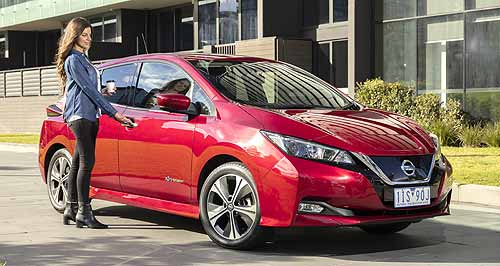Make / Model Search
News - General News - Electric VehiclesEVs to power your homeMajor trial to show how an EV can use downtime to charge the energy grid9 Jul 2020 By NEIL DOWLING HOME energy of the future could be as close as the car in your garage as Nissan this week unveiled plans for a trial using its electric Leaf hatch to put electricity back into the grid.
The Australian Renewable Energy Agency (ARENA) is funding a $2.4 million trial of vehicle-to-grid (V2G) charging systems with the aim of seeing how two-way charging can help energy needs and at the same time, pay car owners for the electricity generated.
The idea isn’t new. Nissan has V2G capability in Japan and Tesla has integrated V2G technology into its Model 3 and has applied for an electricity license in the UK.
The technology centres on modifying the EV’s charger so that it can become bi-directional. This allows power can be converted from AC to DC to operate the EV, but also be able to flow backwards, from the car’s battery to the AC side to create the DC-AC inverter which gives it V2G capability.
For owners of EVs with this technology, it means a charged EV can download power to other devices, including a house. In the case where an EV is charged from a sustainable source such as solar during the day, power can be redirected to the grid at night and power a house.
The trial, called Realising Electric Vehicle-to-Grid Services (REVS), is being conducted by ActewAGL - a joining venture between ACT government agency ACTEW and energy provider AGL - which centres on replacing conventional vehicles in the ACT government fleet with Nissan Leaf EVs.
Nissan will supply 51 Leafs that will be used during business hours but will be plugged in when not on the road.
ARENA said this allows for about 70 per cent availability for providing energy for the grid services.
The power generated by the EVs is targeted at maintaining the frequency of the electrical system – smoothing out the electricity demand highs and lows – that is normally done by coal, gas and hydro-electricity power stations.
ActewAGL’s trial will be the first time that a fleet of vehicles using bi-directional chargers will supply the grid with this service, and the first time an EV fleet will be paid for providing electricity services.
It said that by testing new revenue streams such as V2G, it could improve the total cost of ownership of EVs and make the vehicles more attractive to prospective buyers.
In addition, ARENA said fleets make up more than half of all new vehicles sold annually in Australia and the results of this trial will help inform future procurement choices of private and public sector fleet managers.
The ActewAGL trial will involve a consortium of academic, government, transport and electricity system partners including the Australian National University (ANU), JET Charge, Evoenergy, SG Fleet, ACT Government and Nissan.
Data from the trial will be used by the ANU to lead the development of a roadmap for the commercialisation of V2G technology for all stakeholders.
In addition, JET Charge is leading the V2G movement by later this year marketing a bi-directional charger to EV owners in Australia.
ARENA CEO Darren Miller said this trial is an important first step in demonstrating how EVs can support the grid.
“ARENA is focused on commercialising technologies than can aid the integration of EVs into the electricity system,” he said.
“Given its potential capability to provide similar services as household batteries, V2G has the opportunity to transform a vehicle into a revenue generating device for consumers, through access to energy and network service markets and also to provide power solutions for the grid.
“As EV uptake grows, this project will help to unlock a future where EVs are just as critical a piece of the electricity sector as the transport sector.”
ActewAGL’s Group Manager of Product and Strategic Energy Deployments Todd Eagles said: “What’s unique about the REVS project is that we have valuable contributions from across the electricity and transport supply chains.
“It’s a powerful collective of stakeholders invested in supporting the uptake of renewables through vehicle-to-grid capabilities, which have an important role to play in ensuring the resilience and reliability of our energy system.”  Read more |
Click to shareGeneral News articlesResearch General News Motor industry news |











Facebook Twitter Instagram